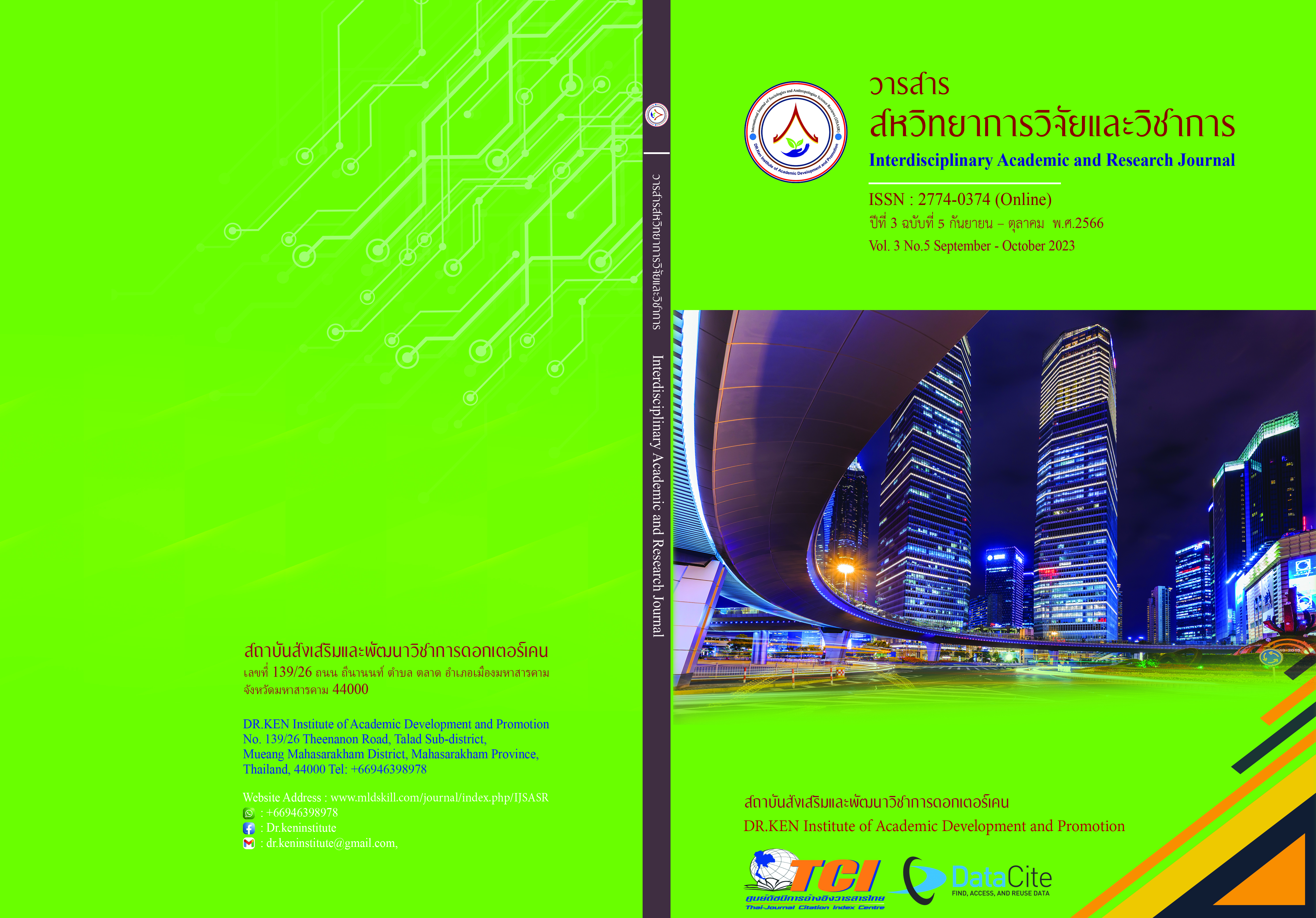The Model-Based Learning Management to Enhance Critical Thinking and Learning Achievement on the Cell and Cell Function of Grade 10 Students
DOI:
https://doi.org/10.14456/iarj.2023.284Keywords:
Model-Based Learning; , Learning Achievement; , Critical ThinkingAbstract
Education development in the 21st century should instill students with critical thinking skills. To teach pupils how to think analytically, distinguish information received, and adapt to changing times. Model-based learning management encourages students to take action. starting from the thought process retrieving information fact study and then taken into consideration and analyzed reasonably lead to conclusions and then used to create a model. This will help encourage students to critical thinking. The purposes of this research were 1) to compare the critical thinking of grade 10 students before and after model-based learning management and 2) to compare learning achievement on the Cell and Cell Function of grade 10 students after the model-based learning management with criteria of 70 percent. The sample group in the study was 26 grade 10 students from Borabue Wittayakarn School, in the first semester of the 2022 school year. They were selected by cluster random sampling. The research instruments included: 1) the eight model-based learning management plans throughout a 12-hour period. The appropriateness of the developed model-based learning lesson plans were indicated by 5 experts at the highest level, the average scores were between 4.46-4.60 ( = 0.02-0.15), 2) the 20 items of four multiple choices critical thinking test based on Ennis and Millman with IOC in the range of 0.80-1.00, discrimination power (r) in the range of 0.46-0.69 and reliability (KR-20) of 0.92 and 3) the 20 items of four multiple choices learning achievement test based on Klopfer with IOC in the range of 0.60-1.00, item difficulty in the range 0.32-0.76, discrimination power (r) in the range of 0.24-0.75 and reliability (Lovett) of 0.89. The research findings showed that 1) Grade 10 students had critical thinking after the model-based learning management statistically higher than before the learning at the significance level of .05. Considering each aspect, the critical thinking in inductive was the highest score and ability to consider the reliability of the data source and observation was the lowest score, and 2) learning achievement of grade 10 students after the model-based learning was higher than the criteria of 70 percent at the .05 level of statistical significance.
References
กระทรวงศึกษาธิการ. (2551). หลักสูตรแกนกลางการศึกษาขั้นพื้นฐาน พุทธศักราช 2551. กรุงเทพฯ: ชุมนุมสหกรณ์การเกษตรแห่งประเทศไทย.
กระทรวงศึกษาธิการ. (2560). ตัวชี้วัดและสาระการเรียนรู้แกนกลางกลุ่มสาระการเรียนรู้วิทยาศาสตร์ (ฉบับปรับปรุง พ.ศ. 2560). กรุงเทพฯ: ชุมนุมสหกรณ์การเกษตรแห่งประเทศไทย.
จงกล บุญรอด และอลิศรา ชูชาติ. (2557). ผลของการจัดการเรียนการสอนวิทยาศาสตร์โยใช้แบบจำลอง MORE ที่มีผลต่อผลสัมฤทธิ์ทางการเรียนวิทยาศาสตร์และความสามารถในการสร้างคำอธิบายทางวิทยาศาสตร์ของนักเรียนมัธยมศึกษาตอนต้น. Online Journal of Education, 10(2), 238-248.
ชัยวัฒน์ สุทธิรัตน์. (2553). เทคนิคการใช้คำถามพัฒนาการคิด. นนทบุรี: สหมิตรพริ้นติ้งแอนด์พับลิสชิ่ง.
ชาตรี ฝ่ายคำตา และภรทิพย์ สุภัทรชัยวงศ์. (2557). การจัดการเรียนรู้โดยใช้แบบจำลองเป็นฐานModel-Based Learning. วารสารศึกษาศาสตร์ปริทัศน์, 29(3), 86-99.
ปรีญานันต์ นวลจันทร์. (2563). ผลการจัดการเรียนรู้โดยใช้แบบจำลองเป็นฐานที่มีต่อผลสัมฤทธิ์ทางการเรียนวิทยาศาสตร์และความสามารถในการคิดอย่างมีวิจารณญาณของนักเรียนชั้นประถมศึกษาปีที่ 5. วิทยานิพนธ์ปริญญามหาบัณฑิต: มหาวิทยาลัยราชภัฏวไลยอลงกรณ์ในพระบรมราชูปถัมภ์: ปทุมธานี.
ภัทราวดี มากมี. (2554). การเรียนรู้โดยใช้ปัญหาเป็นฐาน (Problem-based Learning).วารสารวิชาการมหาวิทยาลัยอีสเทิร์นเอเชีย, 5(1), 7-14.
รัตนาภรณ์ ศุภพร, สุรเดช อนันตสวัสดิ์ และวิทัศน์ ฝักเจริญผล. (2562). การเปรียบเทียบผลสัมฤทธิ์ทางการเรียนเรื่องระบบอวยัวะในร่างกายของนักเรียนชั้นมัธยมศึกษาปีที่ 2 ที่ได้รับการจัดการเรียนรู้โดยการใช้แบบจำลองเป็นฐาน. วารสารศาสตร์การศึกษาและการพัฒนามนุษย์, 3(2), 62-71
สถาบันทดสอบทางการศึกษาแห่งชาติ. (2561). สรุปผลการทดสอบทางการศึกษาแห่งชาติขั้นพื้นฐาน (O-NET). Retrieved on 18 May 2022, from: http://www.newonetresult.niets.or.th/AnnouncementWeb/Login.aspx.
สำนักงานคณะกรรมการพัฒนาการเศรษฐกิจและสังคมแห่งชาติ. (2555). แผนพัฒนาเศรษฐกิจและสังคมแห่งชาติฉบับที่ 11 พ. ศ. 2555-2559. กรุงเทพฯ: สำนักนายกรัฐมนตรี.
สำนักงานรับรองมาตฐานและประเมินคุณภาพ. (2555).การประเมินคุณภาพภายนอกรอบสาม (พ.ศ. 2554-2558) ระดับการศึกษาขั้นพื้นฐานฉบับสถานศึกษา. กรุงเทพฯ: บริษัทพิมพ์ดีจำกัด.
สำนักงานเลขาธิการสภาการศึกษา. (2560). แผนการศึกษาแห่งชาติ พ.ศ. 2560-2579. กรุงเทพฯ:บริษัทพริกหวานกราฟฟิคจำกัด.
อรลออ เผือกนอก. (2563). การจัดการเรียนรู้ชีววิทยาเรื่องการแบ่งเซลล์ ด้วยวิธีการสืบเสาะหาความรู้โดยใช้แบบโมเดลเป็นฐาน. วารสารชุมชนแห่งการเรียนรู้วิชาชีพครู, 1(1), 14-29.
Coll, R.K. (2006). Metaphor and Analogy in Science Education. Netherlands: Springer.
Ennis, R.H., & Millman, J. (1985). Cornell Critical Thinking Test, Level Z. California: Midwest Publications.
Gobert, J.D., & Buckley, B.C. (2002). Introduction to Model-Based Teaching and Learning in Science Education. International Journal of Science Education, 22(9), 891-894.
Hodgson, T. (1995). Secondary Mathematics Modeling: Issues and Challenges. School Science and Mathematics, 95(7), 351-358.
Klopfer, L.E. (1971). Individualized Science: Relevance for the 1970's. Science Education, 55(4), 441-448.
Schwarz, C. V., Reiser, B. J., Davis, E. A., Kenyon, L., Acher, A., Fortus, D., Shwartz, Y., Hug, B., & Krajcik, J. (2009). Developing a Learning Progression for Scientific Modeling: Making Scientific Modeling Accessible and Meaningful for Learners. Journal of Research in Science, 46(6), 632-654.
Windschitl, M., & Thompson, J. (2006). Transcending Simple Forms of School Science Investigation: The Impact of Preservice Instruction on Teachers’ Understandings of Model-Based Inquiry. American Educational Research Journal, 43(4), 783-835.
Downloads
Published
How to Cite
Issue
Section
License
Copyright (c) 2023 Pornpimon Phothaisong, Panwilai Dokmai

This work is licensed under a Creative Commons Attribution-NonCommercial-NoDerivatives 4.0 International License.
Copyright on any article in the Interdisciplinary Academic and Research Journal is retained by the author(s) under the under the Creative Commons Attribution-NonCommercial-NoDerivatives 4.0 International License. Permission to use text, content, images, etc. of publication. Any user to read, download, copy, distribute, print, search, or link to the full texts of articles, crawl them for indexing, pass them as data to software, or use them for any other lawful purpose. But do not use it for commercial use or with the intent to benefit any business.
















.png)


